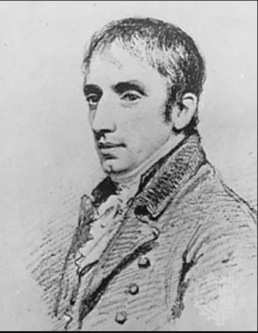These life stories may contain descriptions of childhood trauma and abuse, as well as images, voices and names of people now deceased. If you need help, you can find contact details for some relevant support services on our support page.
Prominent English poet, William Wordsworth (1770-1850), was in foster and kinship care as a child.
William Wordsworth was born to lawyer John Wordsworth (1741-1783) and Ann Cookson (1747-1778). He was the second of five children. Their home was in Cockermouth, Cumbria (historically a part of Cumberland) and, given their affluence, the Wordsworths had servants and indulged William’s love of reading with a membership in a ‘Boys Book Club’.
Ann died in 1778 when William was almost eight years old. On her death, John Wordsworth split up his family. Six-year-old Dorothy went into kinship care with a great aunt in Halifax, sixty-five miles away, and did not see her brothers for nine years. The two younger boys, John and Christopher, both under three years old, went to live with maternal grandparents in Penrith.
John Wordsworth took William and his eldest boy, Richard, to live with him. They would have been cared for by servants as John was often travelling for work.
After fourteen months of living with their father, Richard and William were sent to school in Hawkshead, thirty miles from home. The boys, and later their brothers, John and Christopher, were ‘boarded out’ or fostered to the Tyson family. William remained at the school from 1779 until 1787 when he was seventeen.
Thomas Bowman, the master of Hawkshead Grammar School, was among Wordsworth’s mentors, and lent his precocious charge copies of Cowper’s The Task, Charlotte Smith’s Elegiac Sonnets, and Burns’ Poems when they were first published (Duncan)
For four years there were only occasional visits back home with their father. Then, in 1783, John Wordsworth died as a result of losing his way home after a business trip and spending a night in the cold.
The boys remained with the Tyson’s during term time, but during holidays, they stayed either with their maternal grandparents in Penrith or with one of their two uncles, Christopher or Richard.
In 1787, seventeen-year-old William Wordsworth went to Cambridge, funded by grants and scholarships from the university. During his first two holidays, he returned home to Ann Tyson.
During his last summer as an undergraduate, he and his college friend Robert Jones—much influenced by William Coxe’s Sketches of the Natural, Civil, and Political State of Swisserland (1779)—decided to make a tour of the Alps, departing from Dover on July 13, 1790 (Poetry Foundation).
When he returned to England, he founded he had passed his degree.
In November 1791, Wordsworth travelled to France where he fell in love Annette Vallon and began work on his first collection of poems – he had been writing poetry since he was in school. He left France in December 1792, before Annette gave birth to their daughter, Caroline.
In 1795, William and his sister, Dorothy, commenced living together, first at Racedown Lodge in Dorset, then at Alfoxden House near Nether Stowey – during which time William began his famous collaboration with Samuel Taylor Coleridge – and from 1979 in Dove Cottage, Grasmere.
The stereotypical image of Wordsworth, wandering ‘lonely as a cloud’, uplifted by the daffodils along the shores of Ullswater, or as the elderly Victorian sage of the iconic portraits, is only one side of the famous poet…[he was also a] young radical who celebrated the French Revolution and travelled around Europe; … engaged in politics and society, who believed that love of nature led to love of mankind; [and he was] the compassionate family man writing about the deepest of human emotions, exploring the importance of self-awareness and focused attention – in other words, mindfulness (Wordsworth Grasmere).
William married Mary Hutchinson in 1892 and, with the household quickly expanding, moved with his family to a larger home, Allan Bank, still in Grasmere in 1808.
Wordsworth became a central figure in the English Romantic movement and was named poet laureate of England in 1843, although by then he was rarely writing new verse.
He revised and rearranged his poems, published various editions, and entertained literary guests and friends. When he died in 1850, he had for some years been venerated as a sage, his most ardent detractors glossing over the radical origins of his poetics and politics (Poetry Foundation).
References:
William Wordsworth. https://wordsworth.org.uk/wordsworth/
“William Wordsworth 1770-1850.” Poetry Foundation. https://www.poetryfoundation.org/poets/william-wordsworth
Worthen, John. The Life of William Wordsworth: A Critical Biography. John Wiley & Sons, Ltd, 2014.
Wu, Duncan. “Wordsworth’s poetry to 1798.” In The Cambridge Companion to Wordsworth, edited by Gill, Stephen. Cambridge, UK: Cambridge University Press, 2003.
Image available here.
